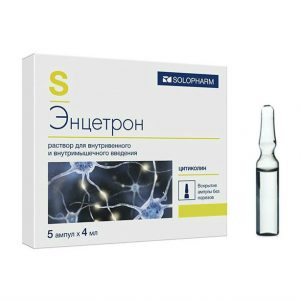Description
release form
65 dfl5frd tablet srdl5p release form
film-coated.
Packing
60 pcs.
Pharmacological action
Pharmacodynamics
Quetiapine is an antipsychotic (antipsychotic). It shows a higher affinity for serotonin receptors (5-HT2) than for dopamine D1 and D2 receptors in the brain. It has tropism for histamine and alpha1-adrenergic receptors, less active in relation to alpha2-adrenergic receptors. No selective affinity for m-choline and benzodiazepine receptors was found.
Reduces the activity of mesolimbic A10-dopaminergic neurons, compared with A9-nigrostriate neurons involved in motor functions. Does not cause a prolonged increase in prolactin concentration. The duration of communication with 5-HT2-serotonin and D2-dopa-new receptors is less than 12 hours.
Pharmacokinetics
Absorption – high, food intake does not affect bioavailability. Communication with plasma proteins – 83%. It is actively metabolized in the liver with the formation of pharmacologically inactive metabolites under the influence of the CYP3A4 isoenzyme mediated by cytochrome P450.
Quetiapine and some of its metabolites have a weak inhibitory effect on the isoenzymes of cytochrome CYP1A2, CYP2C9, CYP2C19, CYP2D6 and CYP3A4, but only in concentrations 10-50 times higher than those which occur at a commonly used dose – 300-450 mg / day.
Excreted by the kidneys 73%, through the intestines – 21%. The half-life is 7 hours. The average clearance in elderly patients is 30 50% less than that observed in patients aged 18 to 65 years. With renal and hepatic insufficiency, clearance is reduced by 25%.
Indications
Acute and chronic psychoses (including schizophrenia) manic episodes in the structure of bipolar disorder.
Contraindications
Hypersensitivity to any component of the drug.
Precautions: Arterial hypotension, epilepsy and epileptic seizures (history).
Use during pregnancy and lactation
Safety and effectiveness of quetiapine in pregnant women have not been established.
Therefore, during pregnancy, quetiapine can only be used if the expected benefit justifies the potential risk.
The extent of excretion of quetiapine in human milk is not known. Women should be advised to avoid breastfeeding while taking quetiapine.
Special instructions
No relationship was found between taking quetiapine and an increase in the QTc interval. However, when using quetiapine simultaneously with drugs that extend the QTc interval, caution should be exercised.
In children, adolescents and young people (under 24 years old) with depression and other mental disorders, antidepressants, compared with placebo, increase the risk of suicidal thoughts and suicidal behavior. Therefore, when prescribing antidepressants in children, adolescents and young people (under 24 years of age) should correlate the risk of suicide and the benefits of their use.
In short-term studies in people over 24 years of age, the risk of suicide did not increase, while in people over 65 years of age it decreased slightly. Any depressive disorder in itself increases the risk of suicide. Therefore, during treatment with antidepressants, all patients should be monitored for the early detection of violations or changes in behavior, as well as suicidal tendencies.
During the treatment period, care must be taken when driving vehicles and engaging in other potentially dangerous activities that require an increased concentration of attention and speed of psychomotor reactions.
Composition
1 film-coated tablet contains:
active ingredients:
quetiapine fumarate (quetiapine hemifumarate), in terms of quetiapine 200 mg
excipients:
hyprolysis (hydroxypropyl cellulose Klucel LF),
calcium hydrogen phosphate dihydrate,
starch sulphate starch microcrystalline cellulose
film coating composition:
AquaPolish D 8107 [hypromellose (hydroxypropylmethyl cellulose), glycerol (glycerin), microcrystalline cellulose, talc, kandurin silver dye ECK ([E555 potassium aluminosilicate, titanium dioxide E171]), based on aluminum lake dye indigo].
Side effects of the
From the nervous system: drowsiness, dizziness, headache, anxiety, asthenia, hostility, agitation, insomnia, akathisia, tremor, convulsions, depression, paresthesia, malignant antipsychotic syndrome (hyperthermia, muscle tension, muscle rigidity) lability of the autonomic nervous system, increased activity of creatine phosphokinase).
From the cardiovascular system: orthostatic hypotension (accompanied by dizziness), tachycardia, fainting, lengthening of the QT interval (no relationship between the use of quetiapine and a constant increase in QTc was detected).
From the digestive system: dry oral mucosa, nausea, vomiting, abdominal pain, diarrhea or constipation, increased activity of liver transaminases.
From the respiratory system: pharyngitis, rhinitis.
Allergic reactions: skin rash, eosinophilia.
Laboratory indicators: leukopenia, hypercholesterolemia, hypertriglyceridemia, decreased thyroxine concentration (first 4 weeks).
Other: lower back pain, chest pain, subfebrile condition, weight gain (mainly in the first weeks of treatment), myalgia, dry skin, decreased vision.
Drug Interactions
While prescribing drugs that have a strong inhibitory effect on CYP3A4 (such as antifungal agents of the azole group and macrolide antibiotics), the concentration of quetiapine in plasma may increase.
In such cases, lower doses of quetiapine should be used. Particular attention should be paid to elderly and debilitated patients. It is necessary to individually assess the ratio of risk and benefit for each patient.
Inducers of microsomal systems of the liver (phenytoin, etc.), thioridazine increase the clearance of quetiapine, inhibitors of liver microsomal systems – at the same time, they reduce the simultaneous administration of quetiapine and antidepressants – imipramine (an inhibitor of CYP2D6) or fluoxetine (an inhibitor of CYP3A4 and CYP2D6) does not significantly affect its pharmacokinetics.
The pharmacokinetics of quetiapine are not substantially altered when given concomitantly with antipsychotic drugs risperidone or haloperidol.
Does not induce the induction of liver enzyme systems involved in the metabolism of antipyrine.
The pharmacokinetics of lithium preparations do not change with the simultaneous administration of quetiapine.
There were no clinically significant changes in the pharmacokinetics of valproic acid and quetiapine when co-administered with divalproex sodium (sodium valproate and valproic acid in a 1: 1 molar ratio) and quetiapine.
Medicines, depressing central nervous system, and ethanol increase the risk of side effects.
Storage Conditions
In a dry, dark place at a temperature not exceeding 25 ° C.
Expiration
2 years.
active substance
Quetiapine
Terms of dispatch from
pharmacies Prescription
Dosage form of
tablet
Vertex, Russia




